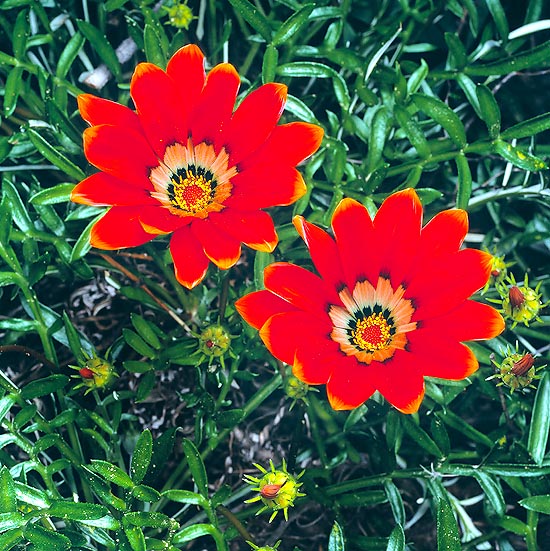Family : Asteraceae

Text © Pietro Puccio

English translation by Mario Beltramini
The plant is native to central-southern Africa (Angola, Botswana, Lesotho, Malawi, Mozambique, South Africa, Swaziland and Zimbabwe), where it prefers to grow on sandy, stony, soils and on rocky slopes.
The genus is honoured to the Byzantine Humanist and translator Theodorus Gaza (ca. 1415-1475) who translated in Latin Theophrastus’ work on botany; the species is named after the German naturalist Georg Ludwig Engelhard Krebs (1792-1844) who was for long time collector of samples of South African flora for the Natural History Museum in Berlin.
Common names: “terracotta gazania”, “treasure flo- wer” (English); “botterblom”, “oranjegousblom” (Afri- kaans).
The Gazania krebsiana Less. (1832) is a perennial cespitose herbaceous plant, about 25 cm tall, with variously shaped leaves when young, then deeply lobed, of dark green colour and rough to the touch on the upper side, due to the presence of short, irregularly distributed, bristles, and covered by a silvery grey tomentum on the lower one.

Easy cultivation and a rich blooming going from spring to late autumn © Giuseppe Mazza
The solitary inflorescence, of about 6 cm of diameter, on a 8-10 cm long peduncle, is the typical flower head of the Asteraceae, formed by a crowd of sessile flowers spirally inserted on a roundish base, the receptacle, surrounded by a campanulate involucre formed by a double series of bracts, the outer ones being about 1 cm long, the inner ones, thin and pointed, being 1,5 cm long.
The flowers of the outer ring, about 20, called ray florets, are about 3 cm long and have the corolla formed by five orange or intense red petals merged together, with a brown dot at the base.
The ray florets are sterile and have the function to attract the attention of the pollinator, like the petals of a single flower. Inside the ring are located the fertile flowers, called disc florets, with tubular corolla with five orange lobes. The fruits, containing one seed only and called achenes (or, more precisely, cypselae), in the Asteraceae, are covered by long hairs and are surmounted by the pappus, the modified calyx of the flower, formed by a crown of long whitish hairs; the pappus has the function to help the dispersion of the fruits.
It easily reproduces by seed, which germinates quickly (1 to 2 weeks), in spring time, or, in winter, in a sheltered location at a temperature of 16 °C to 20 °C; the reproduction may be effected also by division of the tuft.
Plant of easy cultivation, it is considered by many as the most ornamental of the genus due to the long lasting blooming, going from spring to late autumn, and the bright and luminous colours of its flowers.
It may be utilized in full sun (the flowers do not open in the shade), as ground cover, for edges and flower beds, in association with other gazanias, and in rocky gardens, where, often, it will auto-disseminate. It adapts to whatever sort of ground, provided perfectly draining, and may bear long periods of drought and low temperatures, as low as -10 °C, in dry climates; it may be cultivated as annual thanks to its growing speed and the precocity of blooming.
It is suitable also for pot cultivation on particularly draining and aerated substrata; the watering must be moderate in summer, almost stopped in winter, avoiding stagnations which may be lethal.
→ To appreciate the biodiversity within ASTERACEAE family please click here.
